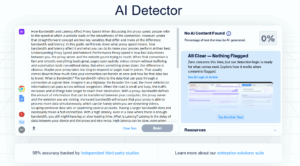When discussing the proxy speed, people refer to the speed at which a website loads or the smoothness of the connection. However, under that straightforward concept are two key variables that differ and make all the difference: bandwidth and latency.
RELATED: Lack of bandwidth hinders e-learning in schools, says Education Ministry
In this guide, we’ll break down what proxy speed means, how bandwidth and latency affect it and what you can do to make your proxies perform at their best.
Understanding Proxy Speed and Network Performance
Proxy speed is how fast data moves between you, the proxy server and the website you’re trying to reach. When that connection is fast and smooth, everything loads great, pages open quickly, videos stream without buffering and automation tools run without delay.
But when something slows down, the difference is obvious. Maybe your proxy takes too long to respond or pages load in pieces. That usually comes down to how much data your connection can handle at once and how far that data has to travel.
What Is Bandwidth?
The bandwidth refers to the data that can pass through a connection at a given time. Imagine it as a highway, the broader the road, the more vehicles (or information) can pass across without congestion. When the road is small and busy, the traffic increases and all things take longer to reach their destination.
With a proxy, bandwidth defines the amount of information that can be transferred between your computer, the proxy server and the websites you are visiting.
Increased bandwidth will ensure that your proxy is able to process more data simultaneously, which can be handy when you are streaming videos, scraping extensive data sets or spamming several accounts.
Having a larger bandwidth does not necessarily mean a fast connection. With a high latency, even in a case where there is enough bandwidth, you still might have lag or slow loading time.
What Is Latency?
Latency is the delay of data between your device and the proxy and vice versa. High latency can be slow, even when you have a lot of bandwidth, for example, speaking over the phone, where there is a delay of a second or two before the other person can hear you.
Latency is measured in milliseconds (ms). The smaller the number, the sooner the reply. 20 ms can be nearly instant, 200 ms can become slow, particularly in gaming or automation.
Distance is a significant factor. Assuming that your proxy is in another part of the world, the information must travel further, which will introduce a delay.
Latency can also be increased by a crowded proxy. So, it’s best to select a proxy that is closer to you or not so crowded, as it is likely to give you a smoother and faster experience.
Measuring Proxy Speed, Bandwidth, and Latency
Want to know how your proxy is performing? Measure its speed, bandwidth and latency directly. These numbers will tell you what’s slowing you down and where to improve.
You can test proxy speed with online tools like Speedtest or command-line tools like Ping and Traceroute. These will show you how fast your data travels, how much bandwidth your connection can handle and how long each request takes to come back.
When testing, make sure no other apps are using your internet connection, this will give you more accurate results. Also, test several times a day as network traffic and server load can change your results.
If you’re too slow or inconsistent, consider upgrading to a better provider. You can check out the proxies with the highest speed.
How to Improve Proxy Speed
Even if your proxy is slow, there are easy ways to make it faster. Here’s what actually matters:
- Buy servers close to you – The closer the server, the faster the connection and lower the latency.
- Use a reliable and high-bandwidth provider – Avoid free or public proxies, which get crowded and unstable.
- Limit background connections – Close out any unused tabs or apps that are eating up your bandwidth.
- Test your setup regularly – In order to detect performance reductions early on, the use of latency and speed tests can be useful.
- Upgrade to premium networks – Providers that have reliable servers with the optimal routes make a huge difference.
Final Thoughts
Proxy speed is the key to how fast and reliable your connection feels. The combination of latency and bandwidth determines the speed at which data goes through a proxy server. More data can flow thanks to high bandwidth and it stays responsive and fast thanks to low latency.
Any delay or inconsistent performance is usually a sign that one of these two problems needs to be addressed. Testing your setup and finding a provider that has good infrastructure can be a game-changer.































